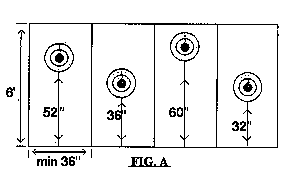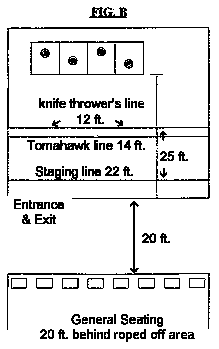Official AKTA competition rules. Events description, rules and requirements: follow this link 1999 new competition format General Rules No member shall represent
the AKTA in communications, transactions, and other arrangements with
businesses, the public, communication media, or represent him/herself as a
spokesperson for the AKTA, or use the AKTA logo in their stationary or club
literature withour written permission from the National Director. Scoring No contestant will be
allowed to interfere with the scorekeeper while the contest in underway. Safety Each contestant will be
required to sign a release of liability to compete.
Contest Rules/Regulations There is to be a minimum
of four targets for the competition. The targets will be a cross section of a
log such as pine, spruce, etc. The targets will be a minimum of 20 inches in
diameter. The targets can be attached to a series of vertical backstops made
from 2x10 or 2x8's as shown in Fig. A. The backstop shuld be a minimum of 36
inches wide and at least 6 feet tall. The targets can be attached to the
backstop using lag screws. The height of each target will be measured from the
floor to the center of the bulleye as shown in Fig. A. The targets will be
placed at various heights as shown in Fig. A, so that you will not be throwing
at the same height and target every time. The idea behind placing the targets
on a vertical backstop is so that we can minimize the number of knives that
will go past the targets and hopefully the missed knives will stick in the
backstop or will be deflected toward the ground where we will have plywood
covered with carpet to help protect our knives.
Rules Governing Tomahawk Throwing All hawks must be of traditional style, metal head and wooden handle or shaft. No modern, all steel integral head and shaft models. Wooden handles must be between 15 and 19 inches measured from bottom tip of handle to top of hawk head. The cutting edge of the hawk blade must be no longer than 4 inches (see Figure A.). The hawk must make one full revolution and stick in the target withh the handle pointing down. As in the knife throw, the throwers score will be the highest ring on the target that the blade cuts. The hawk must remain in the target long enough for the judge to score. The minimum distance line from the target will be 14 feet (see Figure B.). |


 The whole
area, at least 25 feet in front of the targets and all areas on the sides and
behind the targets, will be roped off with only one opening as shown in Fig. B.
to make an entrance and exit for the throwers. No one will be allowed to walk
behind or to the sides of the targets while a practice or a competition is in
progress.
The whole
area, at least 25 feet in front of the targets and all areas on the sides and
behind the targets, will be roped off with only one opening as shown in Fig. B.
to make an entrance and exit for the throwers. No one will be allowed to walk
behind or to the sides of the targets while a practice or a competition is in
progress. 

